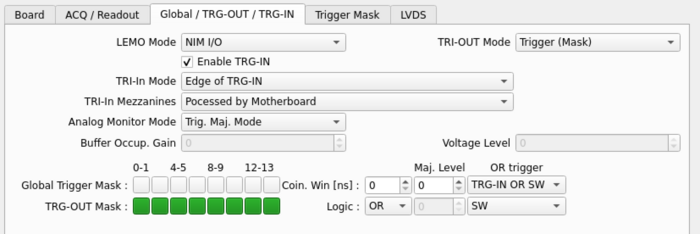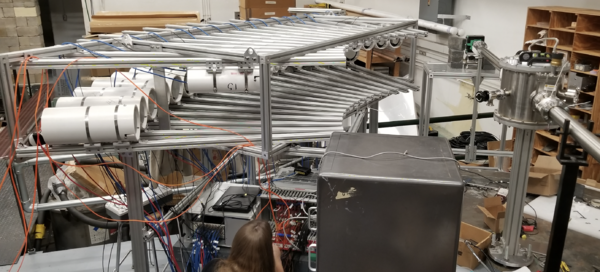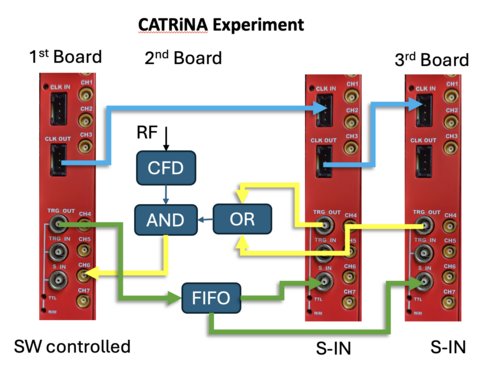CATRiNA: Difference between revisions
No edit summary |
No edit summary |
||
| Line 1: | Line 1: | ||
[[File:CATRiNA at Gamma Station beamline.png|600px|thumb|right|CATRiNA at Gamma Station beamline]] | [[File:CATRiNA at Gamma Station beamline.png|600px|thumb|right|CATRiNA at Gamma Station beamline]] | ||
= Introduction = | = Introduction = | ||
The '''C'''ompound '''A'''rray for '''T'''ransfer '''R'''eactions '''i'''n '''N'''uclear '''A'''strophysics (CATRiNA) <ref name="Perello2019">J. F. Perello et al. NIMA '''930''', 196 (2019) https://doi.org/10.1016/j.nima.2019.03.084 </ref> is neutron detector array located at Florida State University. CATRiNA is composed of 32 deuterated-benzene (<math> \textrm{C}_6 \textrm{D}_6 </math>) liquid scintillators. The array consists of 16 "small" detectors which has 2" x 2" aluminum cell each and 16 "large" detectors that has a 4" x 2" aluminum cell each. Due to the special characteristic of the light-output of the deuterated material with the neutrons, the light-output can be converted to the neutron energy without time-of-flight information <ref name="Morelock2022">A. B. Morelock et al. NIMA '''1034''', 166759 (2022) https://doi.org/10.1016/j.nima.2022.166759 </ref>. | The '''C'''ompound '''A'''rray for '''T'''ransfer '''R'''eactions '''i'''n '''N'''uclear '''A'''strophysics (CATRiNA) <ref name="Perello2019">J. F. Perello et al. NIMA '''930''', 196 (2019) https://doi.org/10.1016/j.nima.2019.03.084 </ref> is neutron detector array located at Florida State University. CATRiNA is composed of 32 deuterated-benzene (<math> \textrm{C}_6 \textrm{D}_6 </math>) liquid scintillators. The array consists of 16 "small" detectors which has 2" x 2" aluminum cell each and 16 "large" detectors that has a 4" x 2" aluminum cell each. Due to the special characteristic of the light-output of the deuterated material with the neutrons, the light-output can be converted to the neutron energy without time-of-flight information <ref name="Morelock2022">A. B. Morelock et al. NIMA '''1034''', 166759 (2022) https://doi.org/10.1016/j.nima.2022.166759 </ref>. Please refer to [[https://fsunuc.physics.fsu.edu/wiki/index.php?title=Python_Iseg_HV_controller&action=edit | this page]] for setting up the HV for CATRiNA. | ||
= Digitizer setup for coincident with RF = | = Digitizer setup for coincident with RF = | ||
Revision as of 22:20, 30 April 2025
Introduction
The Compound Array for Transfer Reactions in Nuclear Astrophysics (CATRiNA) [1] is neutron detector array located at Florida State University. CATRiNA is composed of 32 deuterated-benzene () liquid scintillators. The array consists of 16 "small" detectors which has 2" x 2" aluminum cell each and 16 "large" detectors that has a 4" x 2" aluminum cell each. Due to the special characteristic of the light-output of the deuterated material with the neutrons, the light-output can be converted to the neutron energy without time-of-flight information [2]. Please refer to [| this page] for setting up the HV for CATRiNA.
Digitizer setup for coincident with RF
Digitizer 1 is the master, and received the RF-coin signal. Digitizer 2 and 3 are the slaves, connected to the neutron detectors
The TRG-OUT of digi-2 and -3 will be "on" when ever any channel is fired. To do so, the Local Shaped Trigs [G] must be OR.
also, the TRG-OUT Mode is Trigger (Mask) and the TRG-OUT Mask buttons are green for all channels.

Time sync
Digitizer 1 is SW controll and internal clock. The TRG-OUT mode is "RUN".
Digitizer 2 and 3 are S-IN and external clock.
Contact
Sergio Almaraz-Calderon mailto:salmarazcalderon@fsu.edu
References
- ↑ J. F. Perello et al. NIMA 930, 196 (2019) https://doi.org/10.1016/j.nima.2019.03.084
- ↑ A. B. Morelock et al. NIMA 1034, 166759 (2022) https://doi.org/10.1016/j.nima.2022.166759



